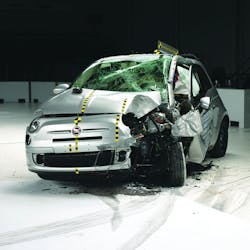University of Extrication: Small Overlap Frontal Crash Testing
SUBJECT: Small Overlap Frontal Crash Testing
TOPIC: New Procedures for Dash-Rolling or Dash-Jacking Evolution
OBJECTIVE: Understand vehicle structural changes related to the small overlap frontal crash testing
TASK: Given images of small overlap crash-tested vehicles, the rescue team shall determine rescue procedures necessary to accomplish the dash-jacking or dash-rolling evolution
A vehicle strays across the yellow center lines and collides with a vehicle traveling in the opposite direction – a common, multi-vehicle collision scenario for first responders. This time, however, rescuers discover that it isn’t a full frontal collision, but rather a situation where both vehicles collided in what is known as a small overlap crash. As the driver’s front corner of each vehicle strikes the other, the momentum of the crash tears into the front fender, destroys the driver’s-side front wheel and suspension systems and tears into the A-pillar and driver’s front-door areas on both vehicles. Usually, the vehicles separate and come to rest on each side of the roadway.
So what are the potential driver entrapment problems we can anticipate in this type of collision? That is exactly what can be learned from the results of a new test being conducted at the Insurance Institute for Highway Safety (IIHS) Vehicle Research Center in Ruckersville, VA.
Referred to as its small overlap frontal test, the crash test essentially recreates damage typically found in a two-way traffic, cross-over scenario. In the Institute’s test, only 25% of a vehicle’s front end on the driver’s side strikes a rigid object at 40 mph. A crash-test dummy is belted in the driver’s seat. Because the crash forces miss most of the built-in crumple zone structure of a typical vehicle, the impact energy tears directly into the front wheel, suspension system and firewall area.
In real-world situations, responders will typically encounter jammed doors, crumpled floorpans, bent rockers and even a displaced instrument panel, especially on the driver’s side. In many cases, the front tire may tear through the floorpan and be visible inside the vehicle. The IIHS small overlap crash testing validates these scenarios quite accurately.
Included in this University of Extrication installment are post-crash images from several IIHS small overlap tests. As you view these vehicles, consider what rescue evolutions you and your team would utilize to free a trapped driver.
As vehicle front structure designs change so the vehicle can perform better in this test, accomplishing dash jacking or dash rolling will soon require significantly more than just one simple cut along the back side of the A-pillar.
Many manufacturers are already designing much larger A-pillars with wider and thicker base designs. To “release” these more reinforced A-pillars during a dash jacking or rolling evolution, rescuers will find it beneficial to cut three of the four sides of the pillar (back side, outside and possibly even the inside of the A-pillar base). Once sufficiently cut through, the A-pillar will finally release and roll or lift away from the trapped occupants.
TASK: Given images of small overlap crash-tested vehicles, the rescue team shall determine rescue procedures necessary to accomplish the dash-jacking or dash-rolling evolution
Dash-Rolling/Jacking Extrication Considerations:
• Completely remove front fender to expose front structure of vehicle
• Completely remove door to allow improved
access to lower A-pillar
• Cut into base of A-pillar on back side, along outside and along inside as much as practical to allow A-pillar to “release”
• Cut a “chunk” out of the large, upper-rail structure as well as any diagonal bracing present to allow movement
• Crib or reinforce rocker of vehicle to ensure vehicle stability during dash evolution
About the Author
Ron Moore
RON MOORE, who is a Firehouse contributing editor, recently retired as a division chief with the McKinney, TX, Fire Department and now serves with Prosper, TX, Fire Rescue. He self-published the Vehicle Rescue 1-2-3 training manual and serves as the forum moderator for the extrication section of Firehouse.com . Moore can be contacted directly at [email protected].

